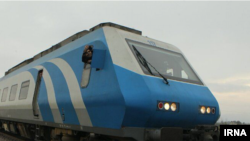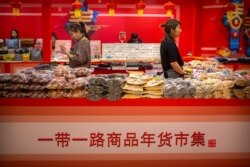The stalling of Iran’s sanctions-hit economy as it battles the coronavirus is unlikely to stop China’s long-running pursuit of infrastructure projects in the Islamic republic, some analysts say.
China has for years been investing in Iran’s energy and transportation sectors as part of its Belt and Road Initiative, a series of Chinese infrastructure projects in dozens of countries aimed at expanding Beijing’s economic and political influence across the globe.
Chinese projects in Iran face uncertainty in the short-term after the nation’s Islamist rulers shut down parts of their already-beleaguered economy to try to slow the spread of the virus that has killed thousands of Iranians. Iranian authorities ordered nonessential businesses to close and banned travel between cities earlier this month.
Some of Beijing’s ongoing infrastructure work in Iran includes the China National Nuclear Corporation’s redesign of an Iranian heavy water nuclear reactor at Arak, and China Railway Engineering Corporation’s involvement in building a Tehran-Qom-Isfahan High Speed Rail Line set for completion next year.
China also has planned to build a petrochemical park in the southern Iranian port of Chabahar, under an April 2018 agreement signed by the China Petroleum and Chemical Industry Federation.
Beijing has insisted that its Belt and Road Initiative remains on course despite the worsening global pandemic. In a March 13 article, state news agency Xinhua said China and its international partners have “maintained their will and steadily pushed forward” with their construction projects.
But no information could be found online from either Chinese or Iranian officials about the status of any Chinese projects in Iran since it reported its first coronavirus cases February 19.
In one indication that Chinese economic activity in Iran has slowed during the pandemic, Chinese state media reported that Chinese passenger planes brought at least 473 Chinese citizens back to China from Iran on several direct charter flights in the first half of March.
TV network CGTN published a video of Chinese passengers on one such flight that landed in the northwestern Chinese city of Lanzhou on March 5. The China Daily news site reported that China Southern Airlines carried out another charter flight to the southwestern city of Chengdu on March 11.
Worries about 'epidemic'
A March 3 article by China’s state-run Global Times news site cited a Tehran-based Chinese citizen as saying most of those awaiting the charter flights were Chinese businesspeople and workers, along with several dozen Chinese students. It quoted another Chinese man living in Iran as saying: “Ninety percent of the Chinese I know in Iran want to go home now. They are worried about the rapid development of the epidemic in Iran.”
Some Chinese companies had been scaling back their ties with Iran before the pandemic, in order to avoid violating U.S. sanctions that the Trump administration has been tightening against Tehran since May 2018. Avoiding U.S. secondary sanctions on Iran-related business has enabled such companies to keep their access to the much more lucrative U.S. market.
Chinese government customs data show China-Iran trade in 2019 shrank 34% from the previous year to $23 billion, driven in part by a sharp reduction in Chinese imports of U.S.-sanctioned Iranian crude oil.
Chinese companies facing U.S. sanctions pressure also withdrew from the Tehran-Shomal Freeway project connecting the Iranian capital to the northern province of Mazandaran, and from the development of the South Pars natural gas field in the Persian Gulf.
“When it comes to the pandemic in Iran, China probably wants to just put things on hold, if not finish some of these remaining projects they started, because they want to stay in Iran,” said Alex Vatanka, an Iran analyst at the Washington-based Middle East Institute, in a VOA Persian interview.
'Lucrative market'
“Iran is potentially a lucrative market for China, which wants to keep its stranglehold on that market and keep out rivals. Why would you let the Germans or anybody else come in and take that away?” Vatanka said. “China also does not want to see the Islamic republic fall because of American pressure, an outcome the Chinese would read as a net loss for themselves, geopolitically.”
Iran also has become more dependent on the continuation of Chinese investments as it struggles with a worsening pandemic, according to Kevjn Lim, an international affairs researcher at Tel Aviv University, in a March 27 op-ed for the Washington Institute for Near East Policy .
“Domestically, Iran faces swelling challenges related to regime legitimacy, socioeconomic instability, violent unrest, the coronavirus, and other problems,” Lim wrote. “Externally, (Iran) must deal with a backbreaking battery of economic sanctions, diplomatic isolation, and military tensions — and China is the only state that is willing and able to help with all three. In the midst of a pandemic, Tehran needs that backstop now more than ever.”
This article originated in VOA’s Persian Service , in collaboration with VOA Mandarin. Mehdi Jedinia and Asim Kashgarian of VOA’s Extremism Watch Desk contributed.








